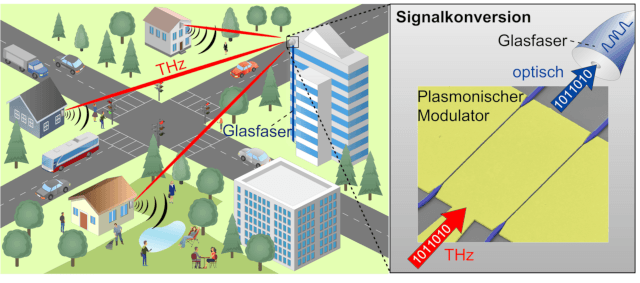
Views: 99
Ultrafast electro-optic modulators convert data streams from wireless terahertz to optical fiber transmission – Publication in Nature Photonics
Courtesy KIT: “6G” Wireless data networks of the future must enable higher transmission rates and shorter delay times and supply more and more end devices. This requires network structures of many small mobile cells. Connecting these cells requires powerful transmission links at high frequencies up to the terahertz range. It is also important to connect the transmission links as seamlessly as possible with fiber optic networks. Researchers at the Karlsruhe Institute of Technology (KIT) use ultrafast electro-optical modulators to convert data signals from terahertz transmission to optical transmission. They report in the journal Nature Photonics (DOI: 10.1038 / s41566-019-0475-6)
While the new 5G mobile phone standard is still being tested, researchers are already working on technologies for the next generation of wireless data transmission. “6G” should allow even higher transmission rates, shorter delay times, greater device density and the integration of artificial intelligence. There are many challenges to be mastered on the way to the sixth mobile generation, both in terms of the individual components and their interaction. Thus, the wireless networks of the future will consist of a large number of small mobile radio cells within which large amounts of data can be transmitted quickly and in an energy-efficient manner. To network these cells, radio links are needed that can transmit tens or even hundreds of gigabits per second on a single channel. For this purpose, frequencies in the terahertz range, which lie in the electromagnetic spectrum between the microwaves and the infrared radiation. Another task is to seamlessly connect wireless links to fiber-optic networks to bring the benefits of both technologies together – high capacity and reliability with mobility and flexibility.
Scientists at the Institutes of Photonics and Quantum Electronics (IPQ), Microstructure Technology (IMT), Radio Frequency Engineering and Electronics (IHE) at KIT and the Fraunhofer Institute for Applied Solid State Physics IAF have a promising approach for converting the data streams from terahertz transmission to optical transmission developed in Freiburg: As they report in the journal Nature Photonics, they use ultrafast electro-optical modulators to convert a terahertz data signal directly into an optical signal, thereby coupling the receiver antenna directly to a fiber. In their experiment, the scientists use a carrier frequency of about 0.29 THz and achieve a transmission rate of 50 Gbit / s. “The modulator is based on a plasmonic nanostructure and has a bandwidth of more than 0.36 terahertz,” explains Professor Christian Koos, head of the IPQ and a member of the collegial leadership of the IMT. “The results show the tremendous potential of nanophotonic devices for ultra-fast signal processing.” The concept demonstrated by the researchers can dramatically reduce the technical complexity of future cell phone base stations and enable terahertz connections at enormously high data rates – hundreds of gigabits per second are envisaged.
Description for the picture:
The seamless connection of wireless transmission links with fiber-optic networks is the key to efficient data networks. Future mobile networks “6G” will consist of many small radio cells that can be flexibly connected via high-performance THz transmission links. At the receiver, the THz signals can be converted directly into optical signals by means of ultrafast plasmonic modulators and transmitted via fiber optic networks.
Original Publication:
- Ummethala, T. Harter, K. Koehnle, Z. Li, S. Muehlbrandt, Y. Kutuvantavida, J. Kemal, J. Schaefer, A. Tessmann, SK Garlapati, A. Bacher, L. Hahn, M. Walther , T. Zwick, S. Randel, W. Freude, C. Koos: THz-to-Optical Conversion in Wireless Communications Using an Ultra-Broadband Plasmonic Modulator. Nature Photonics, 2019. DOI: 10.1038 / s41566-019-0475-6
Abstract at https://www.nature.com/articles/s41566-019-0475-6 External Link
Article in full text (view only): https://rdcu.be/bKsfe External Link
Leave a Reply